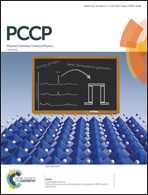Mechanochemically induced sulfur doping in ZnO via oxygen vacancy formation†
Abstract
Surface defects of ZnO nanoparticles were induced via mechanical stressing using a Turbula shaker mixer and a planetary ball mill, and the possibilities for surface modification and functionalization of the ZnO nanoparticles were exemplified by sulfur doping of activated ZnO. Raman spectroscopy reveals that the formation of oxygen vacancies (VO) does not only occur under high stressing conditions in a planetary ball mill but even upon rather ‘mild stressing’ in the shaker mixer. The temporal evolution of the vacancy concentration in ZnO stressed under different conditions can be described by a model that accounts for stress number and vacancy diffusion with diffusion coefficients of VO of 3.7 × 10−21 m2 s−1 and 2.4 × 10−20 m2 s−1 for stressing in the shaker and the planetary ball mill, respectively. The thickness of the VO layer was estimated to be about 1 nm. Thiourea was mixed with defective ZnO particles, and then heated at various temperatures for sulfur-doping. A linear relationship between the amount of induced VO and the level of sulfur doping was found. Remarkably, mechanical activation is indispensable in order to control the level of sulfur doping quantitatively. High-angle annular dark field scanning transmission electron microscopy (HAADF STEM) observations with energy dispersive X-ray spectroscopy (EDX) analysis clearly revealed that the doped sulfur atoms are concentrated at the particle surface. Thus, ZnO (core)/ZnS (shell) structures are obtained easily via mechanochemical activation and subsequent thermal treatment.



 Please wait while we load your content...
Please wait while we load your content...